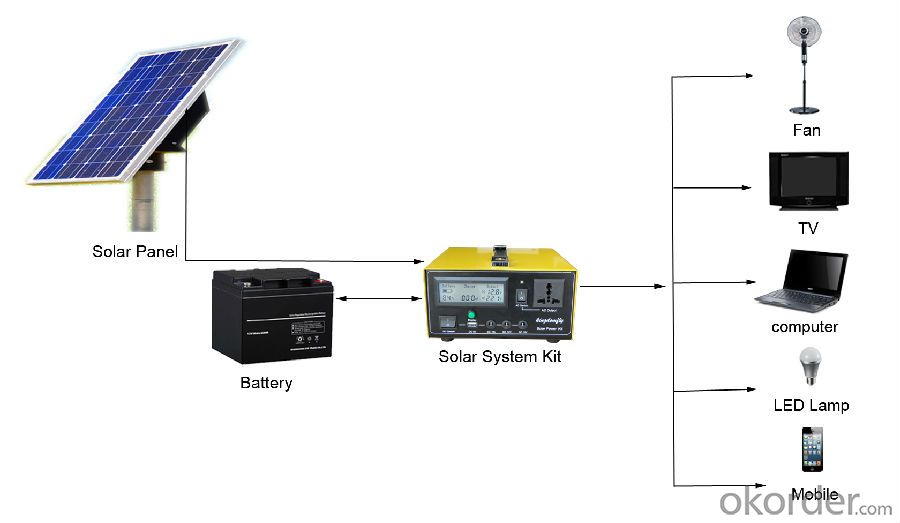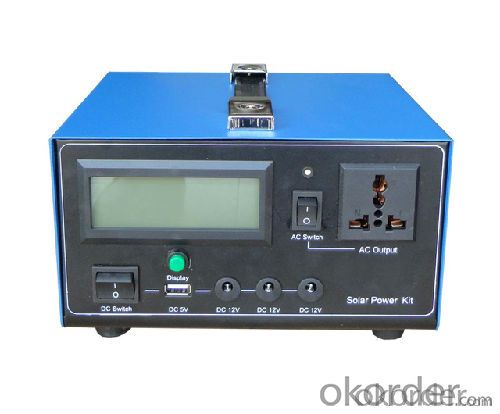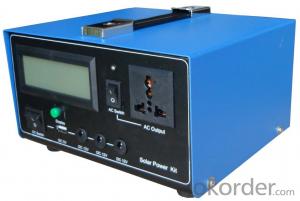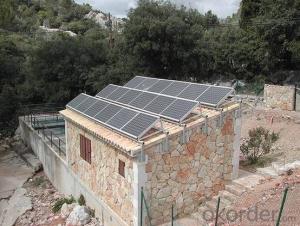Solar Power System Hot Selling SPK_300_LCD
- Loading Port:
- China main port
- Payment Terms:
- TT or LC
- Min Order Qty:
- 10 pc
- Supply Capability:
- 10000 pc/month
OKorder Service Pledge
OKorder Financial Service
You Might Also Like
A solar inverter, or PV inverter, or Solar converter, converts the variable direct current (DC) output of a photovoltaic (PV) solar panel into a utility frequency alternating current (AC) that can be fed into a commercial electrical grid or used by a local, off-grid electrical network.
It is a critical BOS–component in a photovoltaic system, allowing the use of ordinary AC-powered equipment.
Solar inverters have special functions adapted for use with photovoltaic arrays, including maximum power point tracking and anti-islanding protection.
Main Information
KDF SPK_300_LCD
This product is high performance, family used portable solar power system, which can receive energy and store it in battery outside connected to SPK by solar energy on sunny day, and supplies electric power for varies appliances such as electric fan, lighting lamps, television, portable computer etc.
It can supply power for both DC and AC electric application.

Main features:
◆ Battery puts outside connected to the SPK for user to choose battery in recommended range, and easily to exchange battery.
◆ Both DC and AC output
◆ Solar Feedback Circuit Protection
◆ Output Short-circuit Protection
◆ Solar「+」「-」anti-access protection
◆ Output「+」「-」anti-access protection
◆ Over Charged Protection
◆ Over Discharged Protection
◆ Over Load Protection
◆ Over-Temperature Protection
Technical parameters
Specification | Value/Material | |
Item No. KDF | SPK_300_LCD | |
Solar Recommended | Specification | Poly silicon |
Working Voltage/Power | 18V80W~120W | |
Battery Recommended | Rated Voltage/Capacity | 12V65AH~100AH |
Cycle Number | 80% Deep Cycle Number:500 70% Cycle Number:800 | |
Working Temperature | Short Period(one Month):-20~50℃ Long Period(Six Months):-10~45℃ | |
Charging Controller | Operating Voltage | 12V |
Input Voltage | 17.3V~21V | |
Input current | MAX:10A | |
Power Consumption | MAX: 5mA | |
Low Voltage Disconnect(LVD) | 10.8V | |
Low Voltage Reconnect(LVR) | 12.3V | |
High Voltage Discharge( HVC) | 14.6V | |
High Voltage Recharge(HVR) | 13.8V | |
Temperature Protection | 60℃ | |
DC Output | DC output & Application | USB 5V2A |
DC output & Application | DC 12V1*3A | |
AC Output | Output Wave | modified sine wave |
Input Voltage | 11V~15V | |
Output Voltage | 110V±10% | |
Output Frequency | 60Hz±2Hz/50Hz±2Hz | |
Rated Output Power | 300W | |
Maximum VA | 600VA | |
Maximum Efficiency | 88% | |
Temperature | 0-40℃ | |
Over Temperature | 60℃~70℃ | |
Low Voltage Alarm | 11V | |
Low Voltage Shut off | 10.5V | |
High Voltage Shut off | 16V | |
Package | Set size | 278*240*172mm |
Set N·W | 2.8kg | |
Set N·W | 3.6kg | |


No. | Name | Function |
1 | Battery Icon | To show the Volume of the Battery |
2 | Date of % | To show the percent of the Battery |
3 | Charging Icon | To show the charging condition |
4 | Current | To show the value of charge current |
5 | Temperature Icon | Temperature Alarm |
6 | Date of Voltage | To Show the Value of DC output voltage |
7 | Date of Voltage | To Show the Value of AC output voltage |
8 | AC Icon | AC output |
9 | DC Icon | DC output |
This product can be used for any type of solar home systems. It has high conversion efficiency, reliable quality, intelligent monitoring system and best service, which will provide you with a memorable user experience and solutions.
- Q:Are there any risks of electrical fires with solar energy systems?
- Solar energy systems, although generally regarded as safe, do pose potential risks of electrical fires. The improper installation or maintenance of the system stands as one of the primary hazards. Inadequate wiring or faulty electrical connections can result in overheating and fire hazards. Moreover, insufficient grounding of solar panels or system faults can also heighten the likelihood of electrical fires. Hence, it is vital to enlist the services of qualified professionals for both installation and regular maintenance of solar energy systems, effectively minimizing these risks. To further diminish the chances of electrical fires, it is crucial to adhere to fire safety measures, including the use of appropriate wiring, the installation of proper fire detection and suppression systems, and ensuring sufficient ventilation surrounding the solar panels. Consequently, despite solar energy systems generally being safe, it is imperative to acknowledge these risks and implement necessary precautions to mitigate them.
- Q:Can solar energy systems be used in areas with limited roof space due to chimneys or vents?
- Yes, solar energy systems can still be used in areas with limited roof space due to chimneys or vents. In such cases, alternative installation options like ground-mounted solar panels, solar canopies, or solar pergolas can be considered. These options allow for the utilization of unused land or outdoor spaces to generate solar energy, making it possible to harness solar power even in areas with limited roof space.
- Q:Can solar energy systems be installed on flat roofs?
- Yes, solar energy systems can be installed on flat roofs. Flat roofs are actually quite suitable for solar panel installation as they provide a relatively simple and accessible platform. However, it is important to consider factors such as the available space, orientation, and shading to ensure optimal efficiency.
- Q:What are the different types of solar energy systems?
- There are primarily three types of solar energy systems: photovoltaic (PV) systems, solar thermal systems, and concentrated solar power (CSP) systems. PV systems use solar panels to convert sunlight directly into electricity, while solar thermal systems use sunlight to heat water or air for various purposes such as heating buildings or generating electricity. CSP systems, on the other hand, concentrate sunlight using mirrors or lenses to produce steam, which drives a turbine to generate electricity.
- Q:Can solar energy systems be used in disaster relief efforts?
- Yes, solar energy systems can be used in disaster relief efforts. In fact, they have become increasingly popular and valuable in such situations. When disasters strike, they often disrupt the electricity supply, leaving affected areas without power for days or even weeks. This lack of electricity hampers relief efforts, making it difficult to provide basic necessities like lighting, medical care, communication, and clean water. Solar energy systems, on the other hand, can provide a reliable and sustainable source of power in these situations. They consist of solar panels that convert sunlight into electricity, which can be used to power various devices and appliances. These systems can be quickly deployed to disaster-stricken areas, providing immediate access to electricity without relying on traditional power grids. There are several advantages to using solar energy systems in disaster relief efforts. Firstly, solar power is renewable and abundant, ensuring a continuous supply of electricity even during prolonged emergencies. Secondly, solar energy systems are generally low maintenance, reducing the need for constant fuel supply or repairs. This makes them more cost-effective and reliable in disaster-prone areas. Solar energy systems can be used in a variety of ways during disaster relief efforts. They can power mobile charging stations, allowing people to charge their phones and stay connected with their loved ones. Solar-powered lighting can be used to illuminate temporary shelters, hospitals, and walkways, improving safety and security for victims and aid workers alike. Solar energy can also be used to power water purification systems, ensuring a supply of clean drinking water in areas where water infrastructure has been damaged or contaminated. Furthermore, solar energy systems can be integrated into existing relief infrastructure. For example, solar panels can be installed on the roofs of hospitals, schools, and community centers, ensuring a reliable source of electricity for critical operations. This reduces the dependence on diesel generators or other fossil fuel-powered alternatives, which are often expensive, noisy, and emit harmful pollutants. In summary, solar energy systems are highly beneficial in disaster relief efforts. They provide a sustainable and reliable source of power, enabling essential services and improving the overall relief operations. As the world faces more frequent and severe natural disasters, the use of solar energy systems in disaster relief will continue to grow in importance.
- Q:Can solar energy systems generate enough electricity to power a home?
- A home can be powered by solar energy systems, generating sufficient electricity. The amount of electricity produced relies on several factors, including the system's size and efficiency, geographical location, weather conditions, and household energy consumption patterns. Typically, a well-designed and properly installed solar energy system is capable of generating enough electricity to meet a typical home's needs. This system comprises solar panels that capture sunlight and convert it into electricity using the photovoltaic effect. The generated electricity can be utilized for various purposes in a home, such as powering appliances, lights, heating and cooling systems, and other electrical devices. To ensure adequate electricity production, it is essential to consider the home's energy requirements and design a solar system accordingly. This involves determining the suitable number and size of solar panels, as well as incorporating energy storage solutions like batteries to store excess electricity for use during cloudy days or at night. Furthermore, advancements in solar technology, like high-efficiency solar panels and smart inverters, have significantly enhanced the energy output of solar systems. Additionally, many areas have net metering programs that enable homeowners to sell surplus electricity back to the grid, increasing the economic viability of solar energy systems. While solar energy systems are capable of powering a home, it is crucial to evaluate the specific circumstances of each home to determine the feasibility and efficiency of installing such a system. Seeking advice from a reputable solar energy provider and conducting a thorough assessment will assist homeowners in making informed decisions regarding harnessing solar power for their homes.
- Q:Can solar energy systems be used in areas with limited access to educational resources?
- Yes, solar energy systems can be used in areas with limited access to educational resources. Solar energy systems are relatively simple to install and maintain, requiring minimal technical knowledge. Additionally, there are various resources available online and through organizations that provide step-by-step guides and training materials on solar energy systems. This enables individuals in areas with limited access to educational resources to learn and implement solar energy systems, ultimately enabling them to harness clean and sustainable energy.
- Q:Can solar energy systems be used in commercial or industrial applications?
- Yes, solar energy systems can definitely be used in commercial or industrial applications. In fact, many businesses and industries around the world are increasingly adopting solar energy systems to power their operations. These systems can be installed on rooftops, parking lots, or ground-mounted, providing a reliable and sustainable source of electricity. Not only does solar energy help businesses reduce their carbon footprint and lower their energy costs, but it also provides them with long-term energy independence and resilience.
- Q:What is the role of charge controllers in solar energy systems?
- The role of charge controllers in solar energy systems is to regulate the amount of charge going into and out of the batteries. They ensure that the batteries are charged efficiently and prevent overcharging, which can damage the batteries. Charge controllers also protect the batteries from over-discharging, which can reduce their lifespan. Overall, charge controllers help optimize the performance and longevity of solar energy systems.
- Q:Are solar energy systems suitable for agricultural applications?
- Yes, solar energy systems are highly suitable for agricultural applications. They provide a reliable and sustainable source of power for various farming operations, such as irrigation, crop drying, and livestock management. Solar energy systems are cost-effective, environmentally friendly, and can be easily integrated into existing agricultural infrastructure. They also help reduce dependency on fossil fuels, lower energy costs, and contribute to overall sustainability in the agricultural sector.
1. Manufacturer Overview |
|
|---|---|
| Location | |
| Year Established | |
| Annual Output Value | |
| Main Markets | |
| Company Certifications | |
2. Manufacturer Certificates |
|
|---|---|
| a) Certification Name | |
| Range | |
| Reference | |
| Validity Period | |
3. Manufacturer Capability |
|
|---|---|
| a)Trade Capacity | |
| Nearest Port | |
| Export Percentage | |
| No.of Employees in Trade Department | |
| Language Spoken: | |
| b)Factory Information | |
| Factory Size: | |
| No. of Production Lines | |
| Contract Manufacturing | |
| Product Price Range | |
Send your message to us
Solar Power System Hot Selling SPK_300_LCD
- Loading Port:
- China main port
- Payment Terms:
- TT or LC
- Min Order Qty:
- 10 pc
- Supply Capability:
- 10000 pc/month
OKorder Service Pledge
OKorder Financial Service
Similar products
New products
Hot products
Hot Searches
Related keywords






























